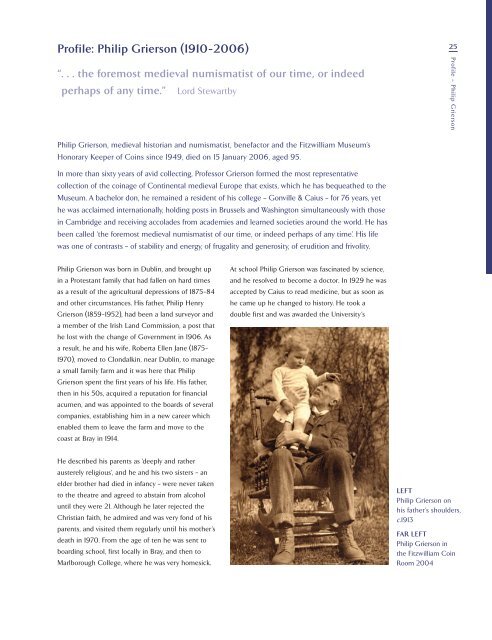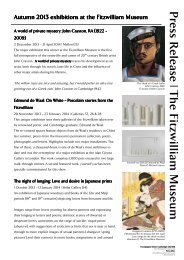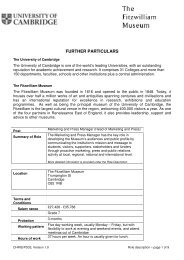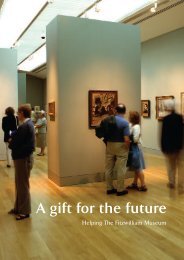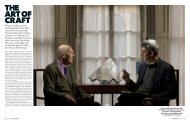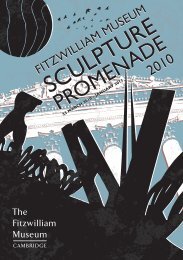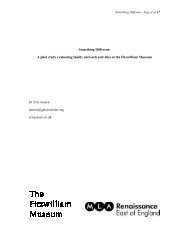Profile: Philip Grierson - The Fitzwilliam Museum
Profile: Philip Grierson - The Fitzwilliam Museum
Profile: Philip Grierson - The Fitzwilliam Museum
Create successful ePaper yourself
Turn your PDF publications into a flip-book with our unique Google optimized e-Paper software.
<strong>Profile</strong>: <strong>Philip</strong> <strong>Grierson</strong> (1910-2006)<br />
“. . . the foremost medieval numismatist of our time, or indeed<br />
perhaps of any time.” Lord Stewartby<br />
<strong>Philip</strong> <strong>Grierson</strong>, medieval historian and numismatist, benefactor and the <strong>Fitzwilliam</strong> <strong>Museum</strong>’s<br />
Honorary Keeper of Coins since 1949, died on 15 January 2006, aged 95.<br />
In more than sixty years of avid collecting, Professor <strong>Grierson</strong> formed the most representative<br />
collection of the coinage of Continental medieval Europe that exists, which he has bequeathed to the<br />
<strong>Museum</strong>. A bachelor don, he remained a resident of his college – Gonville & Caius – for 76 years, yet<br />
he was acclaimed internationally, holding posts in Brussels and Washington simultaneously with those<br />
in Cambridge and receiving accolades from academies and learned societies around the world. He has<br />
been called ‘the foremost medieval numismatist of our time, or indeed perhaps of any time’. His life<br />
was one of contrasts – of stability and energy, of frugality and generosity, of erudition and frivolity.<br />
<strong>Philip</strong> <strong>Grierson</strong> was born in Dublin, and brought up<br />
in a Protestant family that had fallen on hard times<br />
as a result of the agricultural depressions of 1875-84<br />
and other circumstances. His father, <strong>Philip</strong> Henry<br />
<strong>Grierson</strong> (1859-1952), had been a land surveyor and<br />
a member of the Irish Land Commission, a post that<br />
he lost with the change of Government in 1906. As<br />
a result, he and his wife, Roberta Ellen Jane (1875-<br />
1970), moved to Clondalkin, near Dublin, to manage<br />
a small family farm and it was here that <strong>Philip</strong><br />
<strong>Grierson</strong> spent the first years of his life. His father,<br />
then in his 50s, acquired a reputation for financial<br />
acumen, and was appointed to the boards of several<br />
companies, establishing him in a new career which<br />
enabled them to leave the farm and move to the<br />
coast at Bray in 1914.<br />
He described his parents as ‘deeply and rather<br />
austerely religious’, and he and his two sisters – an<br />
elder brother had died in infancy – were never taken<br />
to the theatre and agreed to abstain from alcohol<br />
until they were 21. Although he later rejected the<br />
Christian faith, he admired and was very fond of his<br />
parents, and visited them regularly until his mother’s<br />
death in 1970. From the age of ten he was sent to<br />
boarding school, first locally in Bray, and then to<br />
Marlborough College, where he was very homesick.<br />
At school <strong>Philip</strong> <strong>Grierson</strong> was fascinated by science,<br />
and he resolved to become a doctor. In 1929 he was<br />
accepted by Caius to read medicine, but as soon as<br />
he came up he changed to history. He took a<br />
double first and was awarded the University’s<br />
25<br />
<strong>Profile</strong> – <strong>Philip</strong> <strong>Grierson</strong><br />
LEFT<br />
<strong>Philip</strong> <strong>Grierson</strong> on<br />
his father’s shoulders,<br />
c.1913<br />
FAR LEFT<br />
<strong>Philip</strong> <strong>Grierson</strong> in<br />
the <strong>Fitzwilliam</strong> Coin<br />
Room 2004


